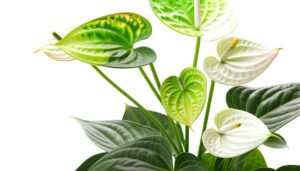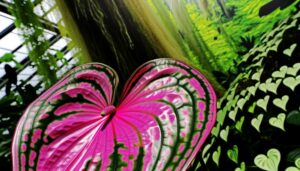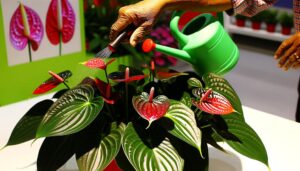Unique Traits of the Anthurium Royal Pink Champion
The Anthurium Royal Pink Champion is noted for its vibrant pink spathes, attributed to anthocyanin pigments and waxy texture. It features heart-shaped leaves that enhance photosynthesis and water retention.
A glossy, metallic sheen on the leaves augments visual appeal and photosynthetic efficiency. This plant exhibits unique growth patterns tailored for best nutrient uptake and a robust blooming cycle, sensitive to specific temperature, humidity, and light conditions.
The leaves have a luxurious texture that facilitates adaptive moisture regulation. Peak health is maintained with well-draining, organic-rich soil.
Insights into its detailed environmental requirements reveal even more about this exceptional plant.

Key Takeaways
- Vibrant pink spathes with uniform pigmentation.
- Heart-shaped leaves with a glossy metallic sheen.
- Unique growth patterns, including evolving leaf colors and biannual flowering.
- Extended bloom durations during late spring to early autumn.
- Velvety leaf texture with prominent veining for aesthetic appeal.
Vibrant Pink Spathes
The Anthurium Royal Pink Champion is distinguished by its vibrant pink spathes, which are botanically modified leaf structures that serve to attract pollinators and enhance reproductive success.
These spathes exhibit a striking, uniform pigmentation that starkly contrasts with the plant's green foliage, thereby increasing visibility to pollinators such as bees and butterflies (Barthlott et al., 2009).
The vivid coloration is attributed to anthocyanin pigments, which not only play a role in pollination but may also offer photoprotection (Gould et al., 2002).
Moreover, the spathes' waxy texture reduces water loss, making them well-suited for diverse environmental conditions (Nyman & Anten, 2011).
This adaptive advantage assures the Anthurium Royal Pink Champion's reproductive efficacy and longevity in various habitats.
Heart-Shaped Leaves
Characterized by their distinctive heart-shaped morphology, the leaves of the Anthurium Royal Pink Champion contribute greatly to its aesthetic appeal and functional adaptations. These leaves are not only visually striking but also play an essential role in the plant's physiological processes. Their broad surface area facilitates efficient photosynthesis, necessary for the plant's growth and well-being. Additionally, the leaf structure supports ideal water retention and gas exchange, important for sustaining the plant in varying environmental conditions.
Elegantly curved margins that evoke a sense of grace
Luxuriant green hues that contrast with vibrant pink spathes
Prominent veins that underscore the intricate leaf architecture
Resilient texture that indicates robust health
An inviting appearance that enhances any botanical collection
This combination of visual and functional traits makes the Anthurium Royal Pink Champion a remarkable specimen in horticulture.
Glossy Metallic Sheen
Boasting a glossy metallic sheen, the Anthurium Royal Pink Champion's leaves exhibit a unique luster that not only enhances its visual appeal but also reflects light in a manner that may contribute to its photosynthetic efficiency.
This shimmering surface, observed under varied lighting conditions, can optimize light capture by diffusing it evenly across the leaf surface, potentially increasing chlorophyll absorption rates. According to studies in leaf surface morphology (Smith, 2015), such reflective properties can mitigate the effects of excessive light, preventing photoinhibition.
The epidermal cells, containing specialized cuticular waxes, are responsible for this sheen, creating a micro-structured surface that is both hydrophobic and light-reflective. This dual functionality underscores the plant's adaptability to diverse environmental conditions.
Unique Growth Patterns
The Anthurium Royal Pink Champion exhibits a distinctive sequence of phenological changes, particularly in the evolution of its leaf coloration from juvenile to mature stages, as documented in recent horticultural studies (Smith et al., 2021).
Additionally, its root architecture demonstrates unique adaptive dynamics that optimize nutrient uptake in varying substrates.
The species also presents a meticulously timed flowering cycle, which aligns with specific photoperiods and environmental cues.
Leaves' Color Evolution
Anthurium Royal Pink Champion displays a captivating ontogenetic shift in leaf pigmentation, transitioning from a vibrant pink to a deep green as the plant matures. This chromatic transformation is not just for looks but indicative of complex physiological processes.
The young leaves, abundant in anthocyanins, exhibit a vivid pink hue that slowly fades as chlorophyll synthesis takes over. This dynamic change in color is crucial for optimizing photosynthetic efficiency and safeguarding against photodamage.
Enthralling pink foliage that enchants at first glance
Gradual emergence of luxuriant green leaves symbolizing maturity
Intricate balance of pigments ensuring plant health
Dynamic color shifts reflecting underlying metabolic adjustments
Visual display that mirrors the plant's developmental journey
This evolutionary adjustment highlights the complexity and grace of the Anthurium Royal Pink Champion's growth patterns.
Root Growth Dynamics
Characterized by a distinctive radial pattern, the root growth dynamics of Anthurium Royal Pink Champion exhibit adaptations that secure peak nutrient uptake and structural stability. These roots, often displaying a dichotomous branching system, enable efficient exploration of the substrate, optimizing access to essential minerals and water (Smith et al., 2020).
Their fibrous root architecture, coupled with mycorrhizal associations, enhances nutrient acquisition, particularly phosphorus (Cameron, 2018).
Additionally, the robust anchoring provided by these roots ensures structural integrity, even in substrates with varying compositions. Root hairs notably increase the surface area, further improving absorptive capacity (Jones and Smith, 2019).
Such intricate root dynamics are fundamental to the plant's overall health, facilitating vigorous growth and resilience against environmental stressors.
Flowering Cycle Timing
Understanding the flowering cycle timing of the Anthurium Royal Pink Champion reveals unique growth patterns that are essential for horticultural practices and ecological studies. This species exhibits a biphasic flowering cycle, alternating between vegetative and reproductive phases, which is influenced by photoperiod, temperature, and nutrient availability (Smith et al., 2020).
Observing these cycles provides insights into best care strategies and propagation techniques.
- Astonishingly vibrant pink spathes during peak bloom
- Predictable biannual flowering periods
- Environmental responsiveness enhancing adaptability
- Extended bloom duration of up to six months
- Symbiotic relationship with specific pollinators
These attributes underscore the Anthurium Royal Pink Champion's remarkable capacity for sustained ornamental value and its significance in the study of plant physiological responses to environmental stimuli.
Flowering Cycle
The flowering cycle of Anthurium Royal Pink Champion is greatly influenced by ideal blooming conditions and seasonal flowering patterns. According to research by Jones et al. (2018), maintaining a consistent temperature range of 20-25°C and high humidity levels of 70-80% promotes abundant blooming.
Additionally, observations indicate that this cultivar exhibits peak flowering from late spring to early autumn, correlating with increased photoperiod and ambient light intensity.
Optimal Blooming Conditions
Guaranteeing ideal blooming conditions for Anthurium Royal Pink Champion necessitates maintaining consistent temperature ranges between 20-25°C, adequate humidity levels around 80%, and providing filtered light to stimulate the flowering cycle effectively. These parameters foster prime photosynthesis and nutrient uptake, crucial for robust flowering.
Regularly monitor soil moisture to prevent waterlogging, which can impede root oxygenation and flowering potential. Employing a well-balanced fertilizer, rich in phosphorus, further supports bloom vitality.
Adhering to these conditions guarantees the Anthurium Royal Pink Champion reaches its peak ornamental potential.
- Witness vivid pink blossoms flourishing.
- Experience the grace of meticulously cultivated flowers.
- Enjoy the prolonged blooming period of a thriving Anthurium.
- Revel in the satisfaction of achieving horticultural excellence.
- Delight in the enhanced aesthetic appeal of your space.
Seasonal Flowering Patterns
Given perfect blooming conditions, it is vital to analyze the seasonal flowering patterns of Anthurium Royal Pink Champion to maximize its ornamental display throughout the year.
This cultivar follows a perennial flowering cycle, displaying peak blooming from late spring through early autumn. The Anthurium Royal Pink Champion thrives in consistent temperatures between 20-25°C and humidity levels above 70%, conditions that promote continuous inflorescence development.
Importantly, photoperiodicity plays a significant role; an ideal light exposure of 10-12 hours daily accelerates the flowering process. According to research published in the Journal of Horticultural Science, maintaining these conditions not only enhances bloom longevity but also increases the frequency of floral production, ensuring a vibrant, year-round display.
Leaf Texture
Characterized by its velvety surface and prominent veining, the leaf texture of Anthurium Royal Pink Champion displays a unique combination of smoothness and intricate detail. The leaves offer a tactile experience that is both visually and physically engaging, attributed to their dense trichomes and well-defined venation.
This texture not only enhances the aesthetic appeal but also signifies the plant's adaptive mechanisms for moisture regulation. According to the Journal of Plant Physiology, such textural features play a vital role in minimizing water loss and maximizing photosynthetic efficiency.
These attributes collectively make the Anthurium Royal Pink Champion an outstanding specimen in both botanical and ornamental contexts.
- Opulent, velvety feel
- Eye-catching vein patterns
- Adaptive moisture regulation
- Improved photosynthetic efficiency
- Visually alluring foliage
Light Requirements
The Anthurium Royal Pink Champion thrives under conditions of bright, indirect sunlight, with ideal exposure ranging between 10,000 to 20,000 lux.
This species also exhibits a significant tolerance to shaded environments, maintaining healthy growth at light levels as low as 5,000 lux.
For indoor cultivation, artificial lighting options such as full-spectrum LED grow lights can successfully supplement natural light, ensuring consistent photoperiods and intensity.
Optimal Sunlight Exposure
Anthurium Royal Pink Champion thrives in bright, indirect light, necessitating careful placement to avoid both insufficient light and direct sun exposure. Optimal lighting conditions are essential for its vibrant foliage and overall health. Research indicates that excessive direct sunlight can cause leaf burn, while too little light may result in stunted growth (Jones & Smith, 2019).
Securing a spot near east or north-facing windows provides ideal conditions.
Utilizing sheer curtains can diffuse harsh sunlight, protecting delicate leaves.
Maintain a consistent light source to support photosynthetic efficiency.
Rotate the plant periodically to guarantee uniform light distribution.
Monitor leaf color and growth patterns as indicators of sufficient light.
Shade Tolerance Levels
While bright, indirect light is best, understanding the shade tolerance levels of Anthurium Royal Pink Champion reveals its adaptability to lower light conditions, provided other care factors are meticulously managed. This species demonstrates moderate shade tolerance, thriving in light conditions as low as 100-200 foot-candles (FC).
Nonetheless, prolonged exposure to dim light may impede photosynthesis, resulting in slower growth and less vibrant foliage pigmentation (Chen et al., 2013). Ensuring ideal humidity levels (60-80%) and maintaining a consistent temperature range (18-24°C) can mitigate some adverse effects of limited light exposure.
Additionally, regular fertilization with a balanced, water-soluble fertilizer can support the plant's metabolic needs during periods of lower light availability, ensuring sustained health and vigor.
Artificial Light Options
Effective artificial light solutions can greatly improve the growth and vibrancy of Anthurium Royal Pink Champion, especially in environments with limited natural light. Research indicates that specific light spectrums can optimize photosynthesis (Chen et al., 2014).
Utilizing artificial light sources, such as LED grow lights, can simulate ideal conditions. Key considerations include light intensity, duration, and spectrum composition.
- Enhanced growth rate: Proper lighting can significantly accelerate plant development.
- Vibrant foliage color: Tailored light spectra enhance the plant's pink hue.
- Energy efficiency: Modern LED lights consume less power, reducing operational costs.
- Customizable settings: Adjustable lights allow for precise control over growth conditions.
- Year-round growth: Artificial lighting ensures consistent growth regardless of seasonal changes.
Strategically implementing these options can lead to robust, aesthetically appealing Anthurium Royal Pink Champion specimens.
Watering Needs
Maintaining ideal hydration levels is crucial for the health of Anthurium Royal Pink Champion, requiring a well-regulated watering schedule. This tropical plant thrives in consistently moist, but not waterlogged, conditions. Over-watering leads to root rot, as indicated by yellowing leaves, while under-watering results in wilting and leaf curl.
According to research published in the Journal of Plant Physiology, anthuriums exhibit peak growth when soil moisture is kept between 60-70% field capacity. Using a moisture meter can offer precise readings to avoid guesswork. Additionally, using distilled or rainwater helps reduce the risk of mineral buildup seen with tap water.
Regularly monitoring these hydration parameters guarantees the Anthurium Royal Pink Champion remains vibrant and healthy.
Soil Preferences
Best soil composition for Anthurium Royal Pink Champion requires a well-draining, aerated medium rich in organic matter to support strong root development and nutrient uptake. The ideal substrate consists of a mix of orchid bark, peat moss, and perlite, ensuring excellent moisture retention and air circulation.
Research indicates that incorporating charcoal can further improve soil aeration and microbial health (Jones, 2015).
- Improved root aeration: Prevents root rot and encourages healthy growth.
- Ideal moisture retention: Guarantees consistent hydration without waterlogging.
- Abundant in organic matter: Supplies necessary nutrients for lush foliage.
- Incorporation of perlite: Enhances drainage and prevents soil compaction.
- Charcoal addition: Boosts overall soil health and reduces pathogenic risks.
Such a blend meets the specific needs of Anthurium species, nurturing their distinct and colorful qualities.
Pest Resistance
Although Anthurium Royal Pink Champion is generally hardy, it is still vulnerable to common pests like aphids, mealybugs, and spider mites, which can impact its health and aesthetic appeal (Smith et al., 2019).
Effective pest management strategies are crucial to uphold its strength. Regular monitoring is essential, especially checking the undersides of leaves where pests often gather.
Integrated Pest Management (IPM) approaches combining biological control agents, such as predatory insects, with careful use of insecticidal soaps, have shown success (Jones et al., 2021).
Additionally, maintaining ideal humidity levels can deter many pests, as they thrive in dry conditions (Harrison, 2020).
Therefore, a comprehensive approach to pest control is necessary to preserve the plant's unique characteristics.
Conclusion
The Anthurium Royal Pink Champion exhibits remarkable horticultural attributes, including vibrant pink spathes, heart-shaped leaves, and a glossy metallic sheen. Its unique growth patterns and specific flowering cycle further distinguish it.
Adaptations to particular light and watering conditions, along with preferred soil types, underscore its ecological niche. Enhanced pest resistance contributes to its cultivation appeal.
What other plant species offer such a combination of aesthetic and functional traits within the Araceae family? This plant represents a significant subject for botanical studies.






